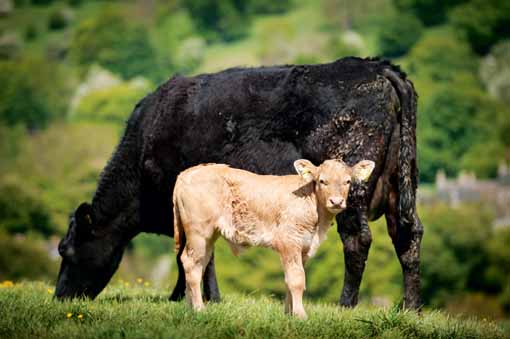Pelvic measurement key for breeding

Alun and Wendy Jacobs are developing a closed herd of 280 Angus-cross and Simmental/Angus cows on their hill farm near Swansea by breeding their own replacements.
Culling animals that don’t suit the system has long been a priority; among the traits scrutinised are fertility, calving history and temperament, and the couple select for milkiness and growth in maternal sires.
The Jacobs have also developed a strict culling policy for their yearling replacements, using pelvic measurements as one of the guides. Their core market is the production of suckler calves for sale at weaning, so it is important that each pregnancy ends in a live birth.
Their vet, Gareth Mulligan, of the Afon Veterinary Centre, Neath, measures pelvic width with callipers and uses these figures to calculate the size of calf that the animal is capable of delivering naturally.
Mr and Mrs Jacob have already used this information to their advantage. Two heifers that Mr Mulligan identified as having narrow pelvises were put in calf to an Angus bull that was specifically selected for its ease of calving history.
Those heifers have since calved but they won’t be retained in the herd. “We will sell them as cull animals because they are narrow and will never be able to calve to a Charolais. They are dairy-bred and not the type of cows we aim to breed. Because of their narrowness they won’t produce the quality calf we need,” Mrs Jacob explains.
The sucklers are run with high genetic-merit Charolais bulls and replacements must be suitable for delivering calves from this breed. In the past some heifers had presented at calving with a misshapen pelvis, necessitating caesarean deliveries.
Mr and Mrs Jacob, winners of the HCC Welsh Charolais Region Welsh Suckler Herd of the Year award, wanted to avoid the cost and health implications of a caesarean and have been convinced that measuring pelvic width is an important factor in reducing calving difficulties. “It makes perfect sense to use this as a means of eliminating issues at calving,” says Mrs Jacob.
Mr Mulligan worked with Mr and Mrs Jacob to develop this system after studying research on a pelvic area/birth weight ratio developed in Nebraska as a method of estimating the size of calf a heifer could deliver without assistance.
He says his priority as a vet is to encourage live births of calves with no health problems and, in light of the high level of caesareans vets perform, he started to question what could be done.
The biggest single loss on beef suckler units is at calving, either at birth or within the first three days of delivery. Mr Mulligan says many calving problems occur in Continental breeds because animals are selected for large back ends and rapid growth. Pelvic area is very heritable and therefore producers must make management decisions prior to breeding to reduce calving difficulty.
“A lot of work has been done in the States on measuring pelvic diameter internally before heifers go to the bull and then using those measurements to predict the actual size of calf a heifer could deliver,” says Mr Mulligan. “We haven’t used it to that extent but we can earmark heifers that have abnormally small pelvises or ones with an abnormal shape.”
This approach, he believes, is becoming relevant as more suckler producers breed their own replacements because of the scarcity of suitable heifers for sale. He says it is important that farmers are aware at an early stage if heifers are suitable for breeding. “The farmer doesn’t want the expense of a caesarean and heifers take longer to come back, it knocks them back physically.”
Mr Mulligan records measurements during routine examinations. He takes two measurements – between the wings of the ilium and from the floor of the pelvis to the sacral vertebrae – in effect the width and height of the pelvis.
“After you have done several animals you develop a consistent approach. Once you are happy with the technique you can produce measurements and estimate the calf weight to pelvic cross-sectional area,” he says.
“If we picked up a heifer with an abnormally shaped pelvis we would advise culling her. If the pelvis is small the decision is up to the farmer, they might use a bull that has good ease of calving figures and watch her very closely, or decide she’s not right for the herd.”
